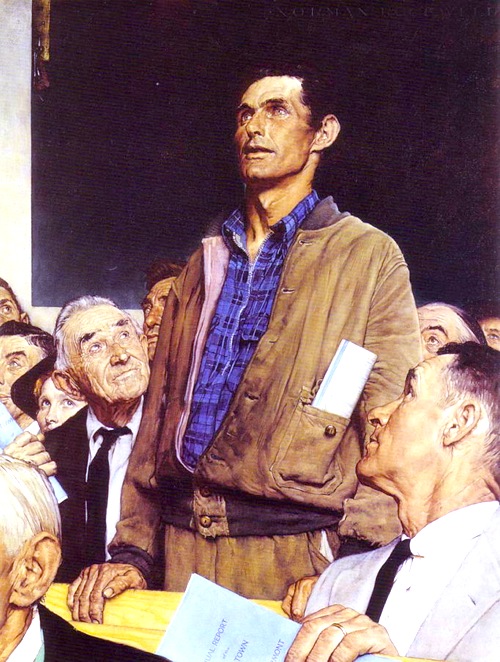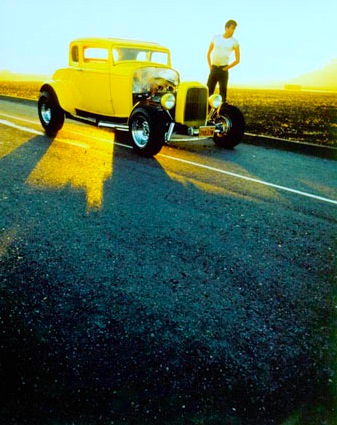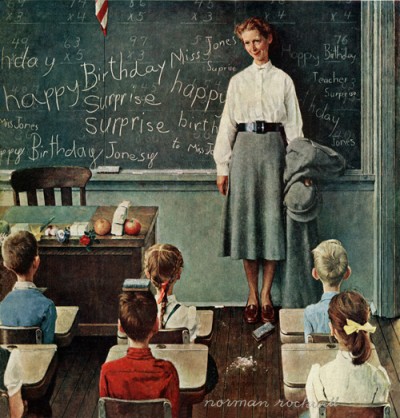
By Jason Apuzzo. I thought it would be appropriate on this day, the Fourth of July, to mention a new exhibit that just opened of Norman Rockwell’s paintings being put on in Washington D.C. at the Smithsonian American Art Museum, entitled “Telling Stories.” The exhibition features 57 major Rockwell works held by George Lucas and Steven Spielberg, who are among the most significant collectors of Rockwell’s work. The exhibit explores Rockwell’s connections to the movies, and also his thematic legacy by way of Lucas and Spielberg’s films. You can read Ted Johnson’s nice article on this exhibit in Variety.
Something that we talk about a great deal here at Libertas is the portrayal of America and what is perhaps its defining attribute – the freedom of its citizens – in film and popular media. Occasionally this is something that is expressed in film in a literal way, in terms of a film’s overt political agenda. More often, however, it’s something that is communicated in a general feeling one gets about whether a filmmaker harbors affectionate feelings toward America and its people.
I happen to think this basic sort of affection or warmth toward America and its people is something that radiates from Lucas and Spielberg’s work when they’re at their best. One thinks here in particular of Lucas’ American Graffiti, with its Capra-esque portrayal of small town California – or of Luke Skywalker, the paradigmatic American farm boy-hero from the original Star Wars. And has there ever been a more stirring invocation of small-town American entrepreneurialism and innovation than Lucas’ film, Tucker: The Man and His Dream? I doubt it. The film, which Lucas made with his friend and fellow innovator Francis Coppola, is a personal favorite of mine.
In Spielberg’s case, almost his entire career has been an exercise in portraying the American Everyman (for which Spielberg endured an enormous amount of criticism early in his career) – from Duel through to Close Encounters of the Third Kind, Saving Private Ryan and beyond. Even in their most recent collaboration, Indiana Jones and the Kingdom of the Crystal Skull, you feel this same sort of affection for America and Americana … particularly in Crystal Skull‘s fun, romanticized approach toward the 1950s, rock-and-roll, Marlon Brando-style motorcycle culture, and Cold War anti-communism.

I wish I felt this kind of basic affection for America flowing out of the younger filmmakers of today. You so often get the feeling that America is a place that filmmakers want to hide today, that it’s something they’re embarrassed by – like some crazy old relative who belongs in an attic. The idea seems to be that in a newly globalized marketplace, America needs to play itself down in order to appeal to audiences in Paris, Moscow, Dubai and Beijing.
Nobody seems to ask, in the midst of all this, whether it’s this new, airbrushed America that the rest of the world really wants. After all, even Kruschev loved cowboys and John Wayne, and once exchanged holiday cases of liquor with the Duke. Stalin is said to have wept at Victor Fleming’s films, and stopped giving out prizes to Soviet film directors until they could “make films like the Americans.”
Filmmakers nowadays don’t always seem to recognize how fundamentally cool America is, how genuinely envied we are around the world for our strength, free-spiritedness and good humor. Filmmakers nowadays seem very eager to reform America, but they really don’t seem to like the place very much.
I miss that basic warmth and affection toward America and her people that filmmakers like Frank Capra, John Ford, Victor Fleming and Howard Hawks used to communicate in their films – the kind of love for America that revels in details, and even in faults and imperfections. You don’t get a whitewashed America in films by Frank Capra, for example (watch Mr. Smith Goes to Washington and you’ll see an almost non-stop depiction of corruption at the highest levels of power in Washington); what you do get, however, is an affectionate and loving portrayal of people struggling to do their best. Think of John Ford’s The Grapes of Wrath, or Victor Fleming’s Gone With the Wind. The America depicted in these films is an America of heartbreak and disappointment, of broken dreams; yet it’s simultaneously an American in which people find ways to endure because of their basic integrity, will-to-live … and the crucial ingredient of freedom. It’s always freedom in America that allows people to discover their second chance in life. Freedom that allows them to survive, rather than be broken by the challenges in their life. Think of John Wayne’s character in Stagecoach, a criminal on the lam romancing a prostitute – played heart-breakingly by Claire Trevor; both characters ultimately get their chance for a new life in the freedom of America’s old West. Who knows what would happen to such people in some other part of the world? Probably they’d just be shot or discarded.

I think it’s wonderful that Messrs. Lucas and Spielberg are putting on this exhibit of Norman Rockwell’s work. And it’s appropriate that the exhibit opens this weekend, because Rockwell’s paintings are really what we so commonly associate with a basic fondness for America and its people – a fondness that expresses itself in details … such as the smile on a child’s face, the crease of a flag, the starch in a sailor’s uniform, the warmth of autumn sunlight. Small, tiny things that taken together make up America – not in an abstract sense, but in the concrete way that only art can properly depict.
Rockwell’s skills as an illustrator were legendary, particularly in his compositional strength. Interestingly, Lucas’ “Young Indiana Jones” television series looks like something copied right from a Rockwell painting (tellingly, one episode even features young Indy sharing an adventure with the young Rockwell). Although Lucas’ films usually veer toward more saturated colors, Spielberg has seemingly copied Rockwell’s muted tones in the more recent films that he’s shot with cinematographer Janusz Kaminski. Rockwell resisted the heavily saturated, Technicolor temptations of his day. Perhaps he associated them with a sublimated form of European-style utopianism? Who can say. All one can say is that American Graffiti, Raiders of the Lost Ark and Saving Private Ryan probably constitute the most visually Rockwellesque films ever made. George and Steven have certainly been ardent students.
Posted on July 4th, 2010 at 2:02pm.
Wonderful write-up, Jason. I didn’t realize Lucas and Spielberg were such fans and collectors of Rockwell.
Actually, I didn’t know that either – and I’ve even been up to Skywalker Ranch and the Presidio several times. But it completely fits in to the early-American, Craftsman-style vibe of everything up at the Ranch … besides reflecting George’s values.
Assuming they weren’t just collecting them as swipe material for movie backround and emotional manipulation 101 studies, then perhaps they actually got some of the real meaning. If so, we should be seeing some Lucas Spielberg movies celebrating America and American values. With the Democrats solidly in office, they don’t even have the excuse that such movies would support the evil Bushitler and the Rethuglicans. .
I think a lot of this comes from people’s upbringing. Lucas and Spielberg had small town, middle-America style childhoods that gave them a reserve of experiences to draw upon.
Nice article, Jason. I have recently found that sweet American vibe in the short-lived TV show Freaks and Geeks (to which I was introduced here). 80s high school with lots of humor and without the raunch. You might want to check it out.
Never caught that show, although LFM’s David Ross has also recommended it to me. Thanks so much for the kind word.
Very touching article. You really summed up all those things that make America great, of which the most important is our individual freedom. Happy 4th of July!
Thanks very much, Serve. Keep posting here at LFM.
CBS Sunday Morning actually did have a segment on them, and it’s interesting how they framed some of their shots like the paintings.
Thanks for mentioning that, Pat!
That’s a great piece, Jason.
I almost forgot about the episode of “Young Indiana Jones Chronicles” that featured Norman Rockwell. I don’t think there will ever be another show with that type of production value, and there certainly won’t be one that’s as educational and entertaining at once.
The site is awesome — keep up the great work.
Hey, thanks Vince, that’s much appreciated. I was up at Skywalker Ranch a few years back when they were putting together all the documentaries that go with those “Young Indiana Jones” DVDs. The amount of work that went into that project was incredible in terms of providing added educational value to the series.
Odd to say, but I actually think that series might have been too cerebral for prime-time network TV. In any event, the series did serve as a laboratory in which George and Rick McCallum got to experiment on a lot of VFX techniques that were eventually put to use in the “Star Wars” prequels.